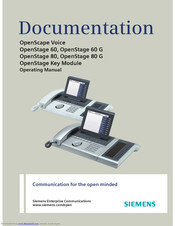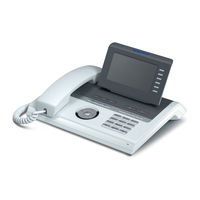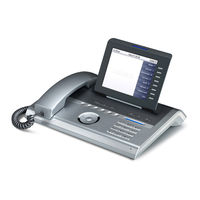Siemens OpenScape Voice Manuals
Manuals and User Guides for Siemens OpenScape Voice. We have 4 Siemens OpenScape Voice manuals available for free PDF download: Administration Manual, Operating Manual, User Manual
Siemens OpenScape Voice Operating Manual (236 pages)
OpenStage Telephones
Table of Contents
-
-
-
Features19
-
-
-
Appearance29
-
-
-
-
Phonebooks39
-
Call Lists42
-
Voicemail45
-
-
Applications48
-
-
-
In U.S. Mode55
-
Group Call56
-
Making Calls58
-
Redial62
-
Callback73
-
-
-
Making Calls99
-
Conference103
-
-
Incoming Calls108
-
Making Calls109
-
During Calls111
-
-
Sample Scenarios119
-
Accepting a Call120
-
DSS Keys123
-
-
-
-
LDAP Database143
-
Call Lists147
-
Privacy/Security
149 -
-
-
Anonymous Calls167
-
Call Tracing168
-
Reachability171
-
Serial Call171
-
Parallel Call172
-
-
Parking a Call173
-
Park a Call173
-
Unparking173
-
-
-
Display177
-
Screensaver182
-
Date and Time185
-
Audio189
-
Bluetooth199
-
Advertisement
Siemens OpenScape Voice User Manual (220 pages)
Telephones
Table of Contents
-
-
Key Module17
-
Keys19
-
Display26
-
Phonebooks32
-
Messages34
-
Voice Mail34
-
Calls35
-
-
-
-
In U.S. Mode46
-
Group Call48
-
Call Control51
-
Making Calls53
-
Redial57
-
Callback70
-
-
-
Forwarding79
-
-
Making Calls99
-
Conference104
-
-
Local Phonebook109
-
LDAP Database112
-
Quick Search114
-
Call Lists115
-
Editing Entries115
-
-
-
-
Incoming Calls116
-
Making Calls117
-
During Calls119
-
-
Sample Scenarios126
-
Accepting a Call127
-
-
-
Privacy/Security
136 -
Mobility
144 -
-
Anonymous Calls154
-
Call Tracing155
-
Reachability158
-
Serial Call158
-
Parallel Call159
-
-
Parking a Call161
-
-
Display165
-
Date and Time167
-
Audio171
-
Key Click178
-
Context Menu182
-
Siemens OpenScape Voice Operating Manual (198 pages)
OpenStage Range Ip phones
Table of Contents
-
-
-
Appearance26
-
-
-
-
Phonebooks36
-
Call Lists39
-
Voicemail42
-
-
Applications45
-
-
Group Call51
-
Making Calls52
-
Redial53
-
Callback63
-
-
-
Making Calls87
-
Conference91
-
-
Making Calls97
-
During Calls99
-
-
LDAP Database114
-
Call Lists116
-
Viewing Details116
-
Deleting Entries116
-
-
Privacy/Security
117 -
-
-
Anonymous Calls139
-
-
Display144
-
Screensaver149
-
Date and Time152
-
Audio156
-
Bluetooth164
-
Advertisement
Siemens OpenScape Voice Administration Manual (240 pages)
Table of Contents
-
-
2 Startup
17-
-
Shipment18
-
Assembly20
-
Key Module23
-
-
Quick Start24
-
-
LAN Settings49
-
-
Redundancy77
-
Lin79
-
Security85
-
Dialing87
-
-
Picture Clips100
-
LDAP Template103
-
Logo106
-
Download Logo108
-
Screensaver109
-
Ringer File112
-
HPT Dongle Key116
-
Speech125
-
RTP Base Port125
-
-
Password138
-
Restart Phone140
-
Factory Reset141
-
Diagnostics145
-
Lldp-Med (V2)145
-
-
Call Connection155
-
Call Log156
-
LDAP Phonebook156
-
DAS Connection156
-
DLS Data Errors157
-
Help Application157
-
Sidecar158
-
Key Input158
-
LAN Connectivity158
-
Local Phonebook158
-
Messaging159
-
Mobility159
-
Speech160
-
Tone160
-
Voice Dialling161
-
Qos Reports162
-
Ping165
-
Core Dump169
-
-
Bluetooth171
Advertisement



